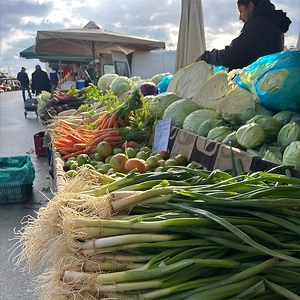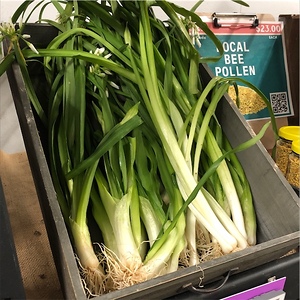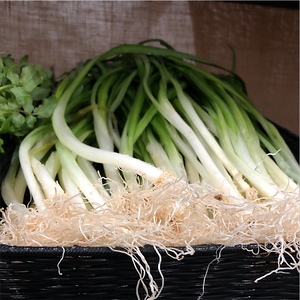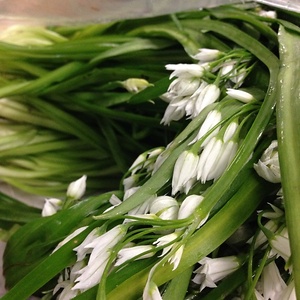


Wild Onions
Estimated Inventory, lb : 0
This item was last sold on : 05/23/24
Description/Taste
Wild onions are a perennial herb featuring vibrant green leaves and stalks, giving them a grass-like appearance. The long, slender, hollow leaves grow in clumps up to 30 centimeters tall. The hollow stalks resemble chives and end in delicate white or light pink blossoms. Once the flowers fall away, tiny bulblets of cloves remain, which are light green and about 1 to 2 centimeters in diameter. The bulb, once peeled, reveals firm, crisp flesh similar to a traditional onion but smaller. Wild onion plants offer a range of textures, from the papery outer skin of the bulb to the smooth, waxy leaves and firm, hollow stalks. Wild onions emit a scent that is more akin to garlic than onions. This garlicky aroma becomes particularly strong when the leaves or bulbs are crushed. It's accompanied by a fresh, green undertone reminiscent of freshly cut grass or herbs. Both the leaves and flowers have a mild flavor while the bulb is crisp and oniony.
Seasons/Availability
Foraged Wild onions are available in the winter and early spring.
Current Facts
Wild onions, botanically known as Allium canadense and part of the Amaryllidaceae family, are also referred to as Canadian garlic, Wild garlic, and Meadow garlic. The allium genus includes both onions and garlic, which is why the names are sometimes used interchangeably, as in the case of Allium canadense. There are over 100 species of wild alliums in North America, so it's crucial not to confuse the edible ones with the poisonous varieties. Wild onions can look similar to Death Camas, a highly toxic plant that can cause excessive salivation, mouth numbness, stomach pain, coma, and even death. Both plants have flowers, small bulbs underground, and long green leaves. Fortunately, you can distinguish them by smell: Wild onions have a distinctive onion scent, while Death Camas does not.
Nutritional Value
Wild onions are high in vitamins A and C, which means they may help support healthy vision, immune function, skin health, and collagen production. These vitamins also have antioxidant properties that can lower the risk of chronic diseases such as heart disease and cancer. Wild onions are rich in potassium, calcium, manganese, and selenium, which support heart health, bone strength, antioxidant defense, and proper metabolic function. Due to their garlic-like properties, Wild onions may help widen blood vessels, thereby lowering blood pressure and reducing the risk of blood clots. They also have antibiotic properties, effective against bacteria, fungi, and other microbes, making them useful for treating bacterial diseases or as a preventative measure at the onset of a cold. Historically, crushed Wild onion bulbs have been used to treat insect bites and stings. Tea made from Wild onion bulbs was used to control coughs, reduce vomiting, and soothe digestive upset.
Applications
The bulbs, leaves, and flowers of Wild onions are all edible. The bulbs, which are the most commonly consumed part, can be eaten raw, cooked, pickled, or dried. They can be used as a replacement for traditional garlic and leeks, sautéed alone in oil, or added to stir-fries, soups, sauces, and spreads. The raw leaves and bulbs can be chopped into salads and garnished with Wild onion flowers for decoration. Wild onions can also be pickled in a vinegar brine with spices or dried for use in seasonings, onion salt, or savory baked goods. They pair well with ingredients like tomatoes, bell peppers, mushrooms, chicken, fish, eggs, cheese, rice, and lentils. Herbs such as thyme, rosemary, and black pepper complement their flavor. To prepare the bulbs, first cut off the roots, remove the outer skin, and chop them up. Despite their general edibility, some people may have sensitivities or allergies to Wild onions, so it's important to consult with a medical professional before consumption.
Ethnic/Cultural Info
Native American tribes were among the first to recognize the culinary potential of Wild onions. They enjoyed eating them raw or cooked, incorporating them into dishes much like a vegetable. They also used Wild onions for making dye, syrups, and as treatments for snakebites, earaches, coughs, and colds. Mexicans were also early consumers of Wild onions. During his conquest from Vera Cruz to present-day Mexico City, Hernán Cortés noted that the local people cooked with onions, leeks, and garlic. He specifically mentioned an onion called xonacatl. Later, Francisco Hernández, a physician to Philip II of Spain, was sent to Mexico between 1570 and 1577 to study the local flora. Hernández described xonacatl as an onion with a "split top," likely meaning it has split bulb like a shallot.
Geography/History
Wild onions are native to eastern and central North America and thrive in various climates, though they prefer access to sun and moisture. They grow in prairies, woodlands, meadows, thickets, stream banks, thinly wooded bluffs, abandoned fields, pastures, areas along railroads, roadsides, and waste areas. While not typically grown commercially in large quantities like common onions or garlic, many home gardeners cultivate Wild onions due to their ease of growth. Wild onions gained popularity when early European settlers in North America adopted their use from Native American practices. They learned to use Wild onions for both culinary and medicinal purposes and began cultivating them in their gardens to ensure a steady supply, making them more accessible to a broader population. Today, Wild onions are more commonly foraged than cultivated and are often found in the wild.
Recipe Ideas
Recipes that include Wild Onions. One
| Honey & Birch |
|
Green Onion Dip |
| Honest Food dot Net |
|
Wild Onion Kimchi |
| B. Britnell |
|
Green Onion & Garlic Crispy Tofu |
| About Food |
|
Bacon, Tomato, and Ramps Quiche |
| Honest Food dot Net |
|
Wild Onion Kimchi |











